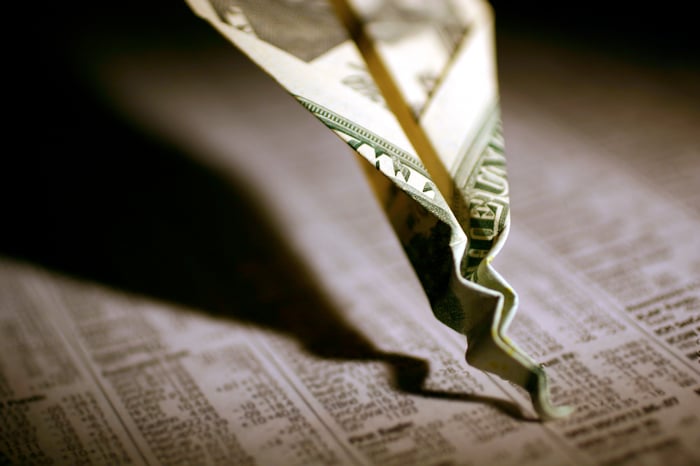This Recession Indicator Hasn’t Been Flawed in 56 Years: This is What It Says Occurs Subsequent – The Motley Idiot
For many buyers, final 12 months served as a reminder that the inventory market would not transfer up in a straight line — even when 2021 made us consider it did. The beginning of a brand new 12 months brings with it new alternative for the enduring Dow Jones Industrial Common (^DJI 1.00%), broad-based S&P 500 (^GSPC 1.89%), and tech-dependent Nasdaq Composite (^IXIC 2.66%), to interrupt out of their respective bear markets.
Nevertheless, the optimism we have witnessed within the Dow, S&P 500, and Nasdaq Composite by way of the primary two weeks of the buying and selling 12 months could have to be placed on maintain based mostly on newly launched knowledge from Federal Reserve Financial institution of New York.

Picture supply: Getty Photographs.
This recession-forecasting instrument hasn’t been fallacious in over a half-century
If there’s an elephant within the room for Wall Avenue, it is the dread ‘r’ phrase: recession.
Whereas there are a selection of macroeconomic indicators that can be utilized to evaluate the probability of a gross home product retracement within the U.S., such because the U.S. unemployment price and the ISM Manufacturing Index, it is the Treasury bond yield curve that is most frequently relied on as a harbinger of bother to return for the U.S. economic system.
In a wholesome economic system, the Treasury yield curve slopes up and to the fitting. This implies longer-dated maturities (10-year and 30-year Treasury bonds) have greater yields than shorter-dated bonds (three-month and two-year Treasury bonds). Since your cash will probably be tied up for an extended interval, the expectation is you will obtain the next yield in return.
However when financial bother and/or uncertainty are brewing, it isn’t unusual for this yield curve to flatten and even invert. A yield curve inversion, like we’re experiencing now, entails short-term-maturing bonds sporting greater yields than longer-dated Treasury bonds. It is a sign that buyers are nervous in regards to the U.S. financial outlook.
For the previous 64 years, the Federal Reserve Financial institution of New York has used the Treasury yield unfold between the 10-year bond price and three-month bond price to calculate the likelihood of a U.S. recession occurring throughout the subsequent 12 months. Over these 64 years, the likelihood of a recession has topped 25% a dozen instances and 40% on eight events.
Apart from a peak likelihood of a recession of 41.14% in October 1966, the New York Fed’s recession-forecasting instrument hasn’t been fallacious if it is surpassed 40%. In different phrases, if the New York Fed’s recession likelihood indicator surpasses 40%, we have had a recession inside 12 months, with out fail, for greater than a half-century. In December 2022, this recession likelihood instrument hit 47.31%. That is the very best studying since 1981, and a really clear indication that financial exercise is predicted to sluggish sooner or later in 2023.
Efficient Federal Funds Price knowledge by YCharts.
Federal Reserve financial coverage is one other ominous warning signal for equities
Nevertheless, it isn’t simply historic yield-curve knowledge that is sounding a warning on Wall Avenue.
For a lot of the previous century, the Federal Reserve has come to rescue of the U.S. economic system and/or Wall Avenue when one or each have faltered. The nation’s central financial institution is thought for taking a dovish stance and easing rates of interest when issues start to look shaky.
For the reason that starting of this century, the nation’s central financial institution has performed three rate-easing cycles, which started on the dates listed under:
- Jan. 3, 2001: The Fed slashed its federal funds goal price from 6.5% to 1.75% in lower than a 12 months, with the S&P 500 in the end reaching its backside 645 calendar days late after this preliminary price discount.
- Sept. 18, 2007: The monetary disaster incented the central financial institution to chop its federal funds price from 5.25% to a variety of 0% to 0.25%. The S&P 500 troughed 538 calendar days after this primary price reduce.
- July 31, 2019: This remaining easing cycle noticed the Fed cut back its federal funds price from a variety of two% to 2.25% to 0% to 0.25%. The S&P 500 hit its nadir 236 calendar days later throughout the coronavirus crash.
For these of you holding rating, that is an common of 473 calendar days after an preliminary price reduce earlier than the S&P 500 bottomed.
In the meanwhile, we’re nowhere close to a rate-easing cycle. In reality, with the U.S. inflation price nonetheless at a blistering 6.5% over the trailing 12 months, the nation’s central financial institution is extra more likely to proceed elevating rates of interest than pause.
Based on projections (i.e., the “dot plot”) from the Federal Reserve Board of Governors, the prospect of a price reduce is not even on the desk till someday in 2024. If it takes a mean of 473 calendar days till the S&P 500 bottoms as soon as a rate-easing cycle begins, we’re, at minimal, two years away from a real backside.

Picture supply: Getty Photographs.
There are good methods to put money into a attainable recessionary/bear market surroundings
If we put the puzzle items collectively, there would seem like a powerful probability of a U.S. recession within the subsequent 12 months, in addition to an prolonged interval the place the present bear market will proceed. Whereas that is in all probability not what buyers need to hear, it is no cause to be chased to the sideline. There are a selection of good methods to place cash to work in a recessionary/bear market surroundings.
One genius solution to struggle again towards financial uncertainty is to put money into dividend-paying firms. The overwhelming majority of publicly traded firms that pay a daily dividend are worthwhile on a recurring foundation and have navigated their method by way of earlier financial downturns. Dividend shares are sometimes well-positioned to trip out inventory market turbulence, they usually present a partial draw back hedge to buyers with their payouts.
One other technique buyers can deploy in any financial surroundings is to purchase extremely defensive firms or people who present fundamental necessity items and providers. As an illustration, Johnson & Johnson (JNJ -0.47%) has been capable of enhance its base annual dividend for 60 consecutive years because of the fixed demand for its prescribed drugs, gadgets, and healthcare providers. As a lot as we would wish to keep away from expensive healthcare payments when the U.S. economic system or inventory market wrestle, we do not get to resolve what ailment(s) we develop or once we’re unwell. It is this demand predictability that is helped Johnson & Johnson thrive for many years — even throughout bear markets.
Do not overlook exchange-traded funds (ETFs) as a sensible solution to diversify or focus your portfolio on the click on of a button. There are actually over 3,000 ETFs for buyers to select from in the USA. In case you have a selected need to speculate based mostly on market cap, progress price, sector or trade, geographic area, or yield, there’s undoubtedly an ETF for you.
The purpose being that persevering with to speculate throughout sizable pullbacks within the Dow Jones, S&P 500, and Nasdaq Composite is a great transfer. Ultimately, all bear market downturns are utterly erased by a bull market rally. That’ll be the destiny of the present bear market sooner or later sooner or later.
from Stock Market News – My Blog https://ift.tt/gux9Job
via IFTTT

